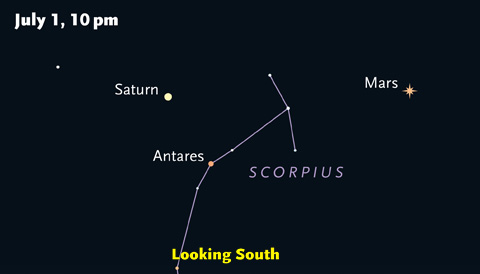Tour July’s Sky: Planets on Parade
For us northerners, July is a time of long, hot days. Yet on July 4th Earth reaches aphelion, the point in its orbit most distant from the Sun. On that date we’re 1.7% farther away than on average.
Throughout July you can find three easy-to-spot planets adorning the evening sky. Soon after the Sun sets, look for Jupiter shining brightly well up in the southwest. This is a special time for the King of Planets, as a NASA spacecraft called Juno has finally reached Jupiter and is going into orbit around it.

Look toward south well after sunset, and you'll find Saturn and Mars mingling with the distinctive stars of Scorpius
Sky & Telescope diagram
Sky & Telescope diagram
Let your eyes drift to the left of Jupiter, and you'll come to the icy-white star Spica. Keep going left, and you’ll soon encounter Mars. The Red Planet is very obvious, yet it’s only half as bright now as it was in late May, when it edged closer to Earth than it’s been in the past decade.
To the left of Mars are two obvious stars. The brighter one, on top, is Saturn, and the one below really is a star, called Antares, which is considered the heart of the constellation Scorpius. Look halfway between Mars and the Saturn-Antares combo for a vertical row of three medium bright stars that mark the Scoprion’s head.
This is just a sample of the great sky sights that await you after sunset. To get a personally guided tour of these night-sky sights and others overhead during July, download our 7½-minute-long astronomy podcast below.
Podcast: Play in new window | Download

No comments:
Post a Comment